There are six basic color patterns in the Appaloosa horse, and endless variations. Appaloosas are best known for their spots, but they have many variations in coat colors. The appy is a very versatile breed that has many desirable qualities.
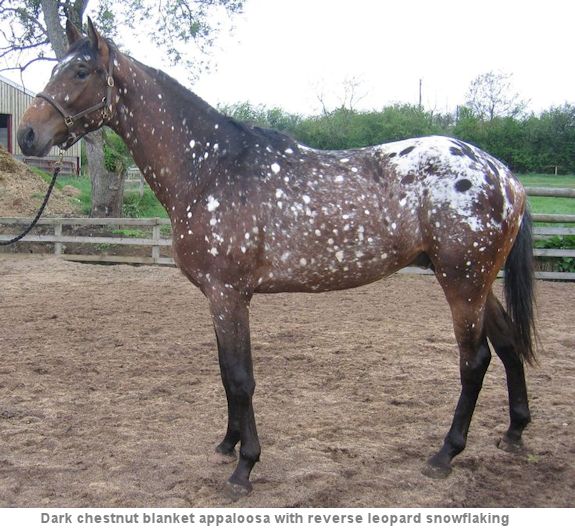 The Appaloosa horse breed is often credited to the Nez Percé Indians, but others disagree. Arab blood was introduced into the breed in the late 19th century, creating a lighter, smaller, more refined type of Appaloosa.
The Appaloosa horse breed is often credited to the Nez Percé Indians, but others disagree. Arab blood was introduced into the breed in the late 19th century, creating a lighter, smaller, more refined type of Appaloosa.
The Appaloosa is a breed of horses that are not only bred for their endurance capabilities and strength but also for the color of their coat and spotting patterns. The Appaloosa Horse Club is currently the third largest horse breed registry in the world.
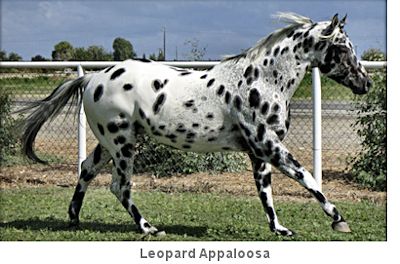 Origin: United States
Origin: United States
Colors:
Six patterns of spots, usually on white or roan hindquarters. The breed has six distinct patterns of spots, but no two horses are exactly the same. Leopard horses are white with darker spots over the entire body, while a Snowflake pattern has a dark coat with white spots.
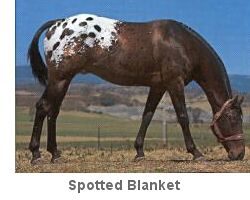 Spotted Blanket coloring is mainly a dark coat with dark spots on white hindquarters or back and a Blanket or White Blanket is any contrasting colored horse with a white blanket but little or no spots in the blanket, concentrated on the rump or loins. A Roan Blanket refers to a horse having the roan pattern consisting of a mixture of light and dark hairs over a portion of the body. The blanket normally occurs over, but is not limited to, the hip area. Roan Blanket With Spots refers to a horse with a roan blanket which has white and/or dark spots within the roan area. The Marble horse has a dark coat at birth that fades almost to white, and the Frost Tip is mostly dark with light spots on loins and hips.
Spotted Blanket coloring is mainly a dark coat with dark spots on white hindquarters or back and a Blanket or White Blanket is any contrasting colored horse with a white blanket but little or no spots in the blanket, concentrated on the rump or loins. A Roan Blanket refers to a horse having the roan pattern consisting of a mixture of light and dark hairs over a portion of the body. The blanket normally occurs over, but is not limited to, the hip area. Roan Blanket With Spots refers to a horse with a roan blanket which has white and/or dark spots within the roan area. The Marble horse has a dark coat at birth that fades almost to white, and the Frost Tip is mostly dark with light spots on loins and hips.
The above are the most common primary patterns in Appaloosas. However, many appaloosa horses have some combination of patterns, and some appaloosas can even be a solid color. A strange but rare combination is an animal that carries both appaloosa and pinto genes, called a Pintaloosa. For more in depth articles about color patterns, and pictures of less common appaloosa color patterns, see more articles in our Horse Colors section.
Other Appaloosa Traits:
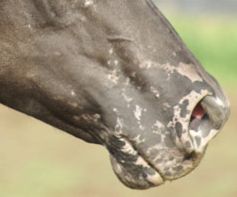 Appaloosa animals will almost always have mottling or small dots around their mucus membranes (mouth, eyes,genitalia, etc). On light or pink skin the freckles are dark and on dark skin they are pink or white. These light skinned areas are susceptible to sunburn.
Appaloosa animals will almost always have mottling or small dots around their mucus membranes (mouth, eyes,genitalia, etc). On light or pink skin the freckles are dark and on dark skin they are pink or white. These light skinned areas are susceptible to sunburn.
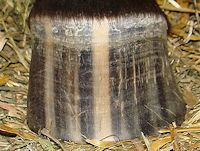 Most appaloosas will have striped hooves to some degree. Not all hooves will display the striping and it does not matter what color the legs are, they can all be striped. The striping may be pronounced like in the picture, or just one or two stripes, or even nearly solid in some animals. Solid colored hooves are most common on animals with white socks.
Most appaloosas will have striped hooves to some degree. Not all hooves will display the striping and it does not matter what color the legs are, they can all be striped. The striping may be pronounced like in the picture, or just one or two stripes, or even nearly solid in some animals. Solid colored hooves are most common on animals with white socks.
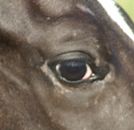 Often appaloosa animals will display a white sclera of the eye. Not all appaloosas will display this trait. This is also referred to as being walleyed.
Often appaloosa animals will display a white sclera of the eye. Not all appaloosas will display this trait. This is also referred to as being walleyed.
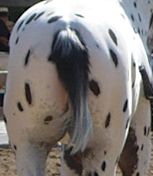 Some appaloosa tails tend to grow very sparsely and the hair won’t grow very long past the end of the tail bone.
Some appaloosa tails tend to grow very sparsely and the hair won’t grow very long past the end of the tail bone.
An appaloosa that does not have an obvious appaloosa color pattern must have at least one of these traits.
Height: between 14.2 and 15.2hh.
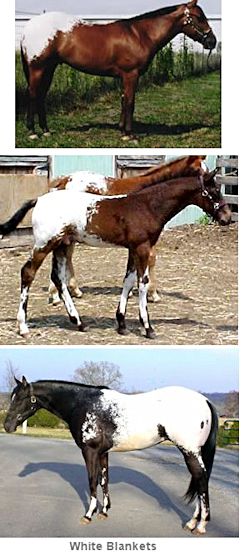 Conformation: short deep body, strong hindquarters, good bone, sure footed.
Conformation: short deep body, strong hindquarters, good bone, sure footed.
Character: Many of the heavier type Appaloosas have a roman nose, which many horsemen think indicates a stubborn streak. Known as nimble footed mountain horses with great endurance.
Uses: western riding, pleasure, circus, dressage, working ranch horse, and all rounder.
Undesirable Traits:
Some appaloosa horses have varying degrees of night blindness. This means in low light, they may not be able to see shapes like we do, but instead see pitch blackness.
This can possibly make the animal harder to train, because he might be fearful in low light situations like night riding, loading into trailers with low light, or in dimly lit barns. Low light means it is probably too dark to read a book.
Night blindness is present from birth, and there is nothing that can be done to fix it. However, because the condition is present at birth, night blind animals usually learn to compensate for this disability to a great extent. Night blindness is associated with specific coat patterns in the Appaloosa.
History:
Pre-historic horses in France and Spain as long as 35,000 years ago have been proved through DNA analysis to have carried a “spotted” gene similar to the patterns seen in Appaloosas today. They were once highly prized in Europe and sought out by royalty and the rich –until they became commonplace. Once that happened, the no longer fashionable spotted horses were readily surplused and many were shipped to the New World. Because the Europeans bred just about anything together in trying to achieve the spotted horse, many of these animals were not of the best conformation.
The Spanish introduced horses to Mexico in the 1500s. Spanish explorer Hernando Cortez was known to bring a lone spotted horse with snowflake patterning to the New World. Following the Pueblo Revolt of 1680, horses rapidly spread throughout North America, reaching the Pacific Northwest around 1700, and the Nez Perce tribe shortly after. A tribal legend of the Nez Perce indicates that the first ‘”spotted horses” arrived aboard a Russian ship in the early 1700’s. They selectively bred the spotted horses to wild Mustangs.
When the Lewis & Clark expedition met up with the Nez Perce in 1806, they estimated 10% of their horses had the spotted coat pattern we associate with the Appaloosa today. White observers visiting the Nez Perce camp at Lake Tolo, just before the 1877 war began, estimated that from a third to a half of all the Indian horses at the camp were Appaloosas.
The Nez Perce were one of the few native American indian tribes that had a selective breeding program, and castrated inferior stock. The horses they developed were known to be sure footed, fast, easy keepers, with the stamina to travel extraordinarily long distances over rough terrain, yet were fleet enough to catch up with the bison on buffalo hunts, yet nimble enough to stay out of their way during the dangerous hunts.
Many of the Nez Perce resided along the Palouse River in what is now Central Idaho. Early settlers began to refer to their hardy horses as Palouse Horses, which eventually became known as a “Palousey,” “Appalousey,” and finally “Appaloosa.”
On September 9th, 1858 after a Nez Perce battle with the US Calvary near the Four Lakes area, which is now known as Spokane, Washington, over 800 Nez Perce horses were captured by the soldiers. It was decided to select 130 out for the calvary’s use, and then to kill the rest.
According to an eye witness, “To save ammunition, colts were knocked in the head… At first they led the horses down to the river gravel bar, but it became too time consuming so they ended up shooting them in the corral constructed by banks, the river and a rope fence on the east side where there was no other containment naturally available.”
Captain Keyes observed, “It was a cruel sight to see so many noble beasts shot down. They were all sleek, glossy, and fat, and as I love a horse, I fancied I saw in their beautiful faces an appeal for mercy. Towards the last the soldiers appeared to exult in their bloody task; and such is the ferocious character of men.”
Even as late as 1911 the bleached bones of the slaughtered horses could be seen along the banks of the Spokane river.
When white settlers began to encroach on Nez Perce lands in Oregon, the US Government tried to force relocation of the natives to indian reservations. This resulted in the famous flight of Chief Joseph’s and other Nez Perce bands on an epic 1100 mile journey which came to be called the Nez Perce War of 1877.
When they finally surrendered, over 1,000 more Nez Perce horses were shot. Some of the remaining appys were auctioned off to settlers. Some animals escaped and some were abandoned, with a significant population of the Appaloosa horses having been left behind in the Wallowa Valley in Oregon due to a hasty retreat.
Perhaps fearing the qualities of the Appaloosa would be revived, leading to another Indian uprising, a federal law was passed and remained on the books until 1935 that prohibited the breeding of Appaloosa to Appaloosa. The Appaloosa could only be bred to draft horses. In a relatively short time, the original Appaloosa breed type all but disappeared.
In 1937, the Western Horseman magazine ran an article on the Appaloosa, appealing to the public to preserve and improve the rapidly disappearing Appaloosa breed. An interest in the Appaloosa was revived, and in 1938, Claude Thompson, a long-time Appaloosa breeder, along with the help of a small group of dedicated horsemen, established the Appaloosa Horse Club.
In 1947 George Hatley was appointed executive secretary of the ApHC and the club’s records, contained in a shoe box, were moved from Moro,Oregon to the Hatley’s house in Moscow, Idaho. At this time there were 200 registered horses and 100 members.
Over the next two decades the Appaloosa Horse Club grew by leaps and bounds, necessitating four moves to larger quarters. George Hatley continued to lead the ApHC for 31 years until his retirement in 1978. At this point, over 300,000 Appaloosas had been registered and the ApHC was the third largest registry among light horse breeds.
Presently, the ApHC is an international breed registry with more than 635,000 Appaloosa records and 33,000 members.
The Nez Perce tribe is developing an offshoot breed called the Nez Perce Horse, by breeding Appaloosa mares to four founding stallions from the Akhal-Teke horse breed.
